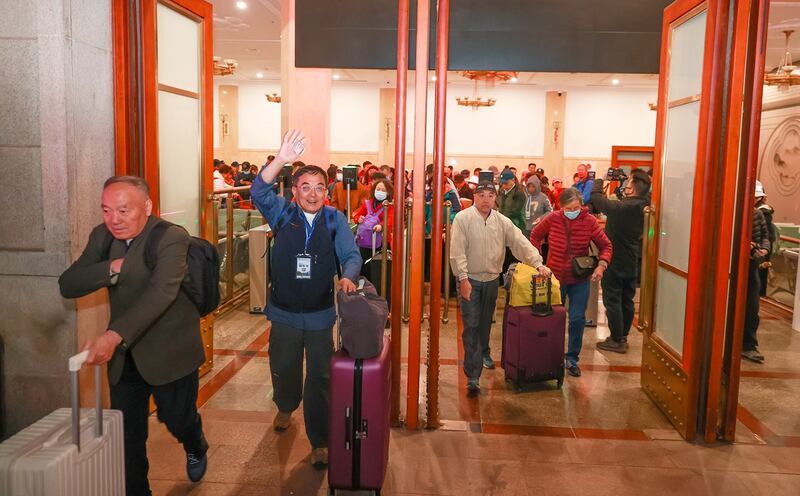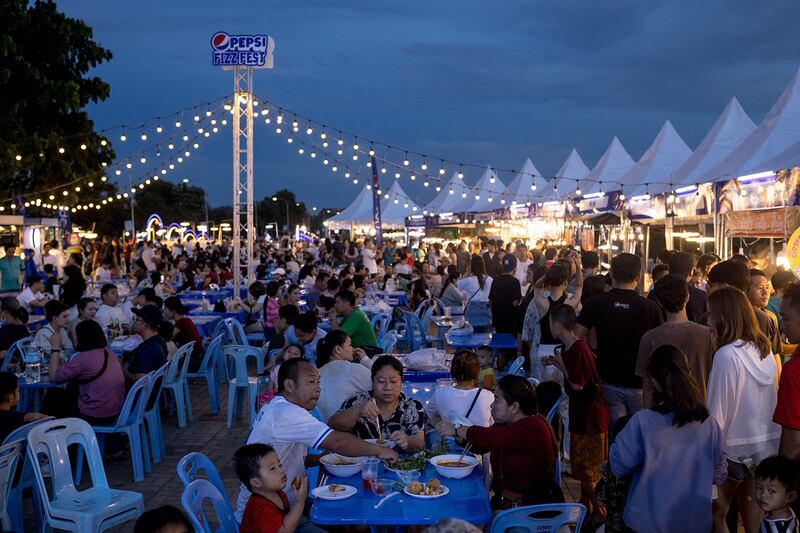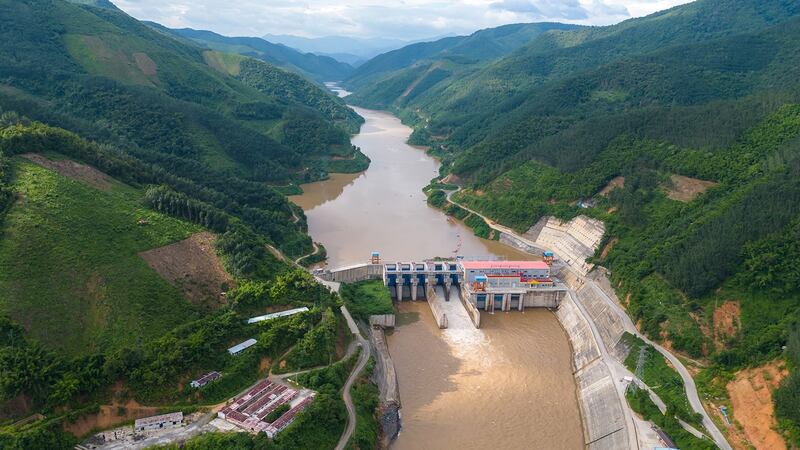It may sound perverse to say – given that inflation in Laos has been at one of the highest rates in Asia since 2022, the national debt stands at more than 130 percent of GDP – but the second-poorest nation in Southeast Asia has many reasons for optimism.
Tourism is likely to return to pre-pandemic levels this year. Its ASEAN chairmanship this year is greatly boosting its international profile—and, thus, international trade prospects.
Vientiane has sensibly bet on food exports to China, since China's demographics are arguably the worst in the world and is set to have the fastest population decline in human history. Even today, China cannot feed itself. It imports around 65.8 percent of all foodstuff.
Although that was down from 93.6 percent in 2000, external demand is likely to rise in the coming years as its working-age population collapses, forcing even more rural folk into the cities and industries.
It is therefore a solid bet by Vientiane that agriculture exports to China will grow in the coming decades. Its exports increased to $1.4 billion in 2023, up by a quarter from the previous year.
The Vientiane-Kunming railway has already expanded export opportunities into China. If Laos can attract interest from consumers further west, in Central Asia and Europe, it can use the railway links through China to increase trade.
Better still, if Laos can extend its rail network down to Thailand’s ports, again thanks to Chinese investment, that would make it easier and cheaper to export its goods further afield.

Better than that, Vietnam has pledged to connect Laos via railways to its port in Vung Ang, which would make it easier for trans-Pacific exports, opening up Laos’ producers to the U.S. market.
Politically, too, the communist Lao People's Revolutionary Party can be confident in its own monopoly on power. There is no meaningful resistance group among the diaspora or at home. Unlike communist Vietnam, there is nothing like a pro-democracy movement.
Perhaps most heartening for Vientiane, and something often overlooked, Laos has the youngest population of all the ASEAN states and the healthiest-looking demographics over the coming three decades.
Just 4.7 percent of the population is aged above 65. Some 65.4 percent are of working age (15-64) and 29.9 percent are below the age of 15. By 2050, the working age population will actually grow to 68 percent, while just a tenth will be of retirement age by that year.
Aged versus aging societies
By comparison, in 2050, a fifth of Vietnam's population will be aged 65 and over. In Thailand it will be around a third.
Laos won’t become an “aging society” – when 7 percent of the population is aged above 65 – until 2035. It won’t become an “aged society” – when the over-65 cohort is above 14 percent) – until 2059. One reason for this, however, is the country’s shorter life expectancy.
Vietnam became an “aging” society in 2011; Thailand became “aged” in 2020. Moreover, when Thailand became an “aging” society in 2002 its GDP per capita was $2,091. Vietnam reached it in 2011 when its GDP per capita was $1,953.
Laos’ GDP per capita stands at $2,535, and it still has another decade or so before it touches “aging” society status. This means that Laos has at least 30 years before demographics start to bite, and even by 2050 there will still be double the number of youngsters aged 0-15 than retirees. That gives Laos three decades to expand industry and output.
For these reasons, political leaders in Vientiane often give off the air of extreme patience, as though they’re sitting pretty on borrowed time.
On the trade front, Laos achieved above 7 percent growth rates in the 2010s when its trade was almost entirely with its immediate neighbors. New infrastructure could open up vastly more markets and attract far more investment in industry and manufacturing, which remains nascent.

Railway connections to ports in neighboring countries can help Laos overcome its landlocked confinement at the same time as its workforce booms in number – with around 2 million Laotians to be added to the workforce by 2050.
However, not all is well. The economy has been shockingly bad since 2020, not all of which was caused by the COVID-19 pandemic.
The government and central bank have been incompetent in constraining inflation—and just about all other economic ailments.
The national debt started to climb to unmanageable levels by 2018. Laos imports too much and has barely any control over exports.
The government admits that close to a third of export revenue doesn't reenter the country. Mostly it is funneled to foreign-owned companies, or profits are hidden, denying Laos a massive chunk of available taxes.
Education, tax collection concerns
It’s unlikely that Laos can fully weaken itself off imports. Dispensing of its petroleum dependency would be sensible, given that Laos produces more than enough energy through its hydropower dams.
But that means converting most transport and machinery to electric battery-powered, which is simply too expensive for most countries, not least Laos. It still also relies massively on imports for agricultural inputs such as fertilizers.
Since 2020, ever greater numbers of Laotians have left to find work abroad, mainly in Thailand. This has depopulated many rural communities, leaving the elderly to tend to the young. Many of those who have left are the better-educated.
At the same time, the education sector is now in poorer health than pre-2020, although government spending on education began to fall as a percentage of GDP much earlier. Non-attendance or absentee rates are high among students, and teacher numbers are dwindling.
It’s difficult to see how this generation of children, buffeted by the pandemic and shoddy schooling, will become as educated as Laos needs them to be in order to move up supply chains.
These are relatively manageable problems, however, since Vientiane does have the capacity to rectify them.
It could, as advised by every international agency, get tough on revenue collection, including tax lost to corruption. This would allow it to increase investment in education, thus making the third of the population now aged 0-14 years old better prepared for the intelligence-based industries of the future.

Greater revenue would also ease the debt burden. Laos needs to assert control over special economic zones (SEZs), hotbeds of illicit activity and lost revenue. The government’s draft law on SEZs was rejected by the National Assembly in November because it was too soft on foreign businesses, but a revised version could be tougher.
But there are more existential problems.
First is the looming economic decline of China. Perhaps sensibly, Vientiane has seemingly operated on the belief that vast Chinese investment won’t last forever—which it won’t.
For some, Laos’ willingness to accept pretty much any investment deal from China is rooted in dependency or a “trap” laid by Beijing, as though Vientiane’s carefreeness is forced upon it.
More likely, Vientiane knows that at some point, perhaps near the end of this decade, Beijing will become much more focused on its own stagnating economy and its own dire demographics, meaning less money will flow out from the Chinese state. So better to take what money China offers now before it runs out.
However, China's fall could be harder and more consequential than most people predict. That matters when China accounts for a third of Laos' exports and a fifth of its imports, and the majority of its inward investment.
What this means for Laos' national debt – most of which is owed to China – is uncertain. For now, while Beijing is obsessed with geopolitics, it's unlikely to let a key partner go bust. But looming chaos in China might mean that Beijing readjusts its priorities.
Deglobalization and emigration
The trade benefits that Laos thinks it might get by being better connected to Thai and Vietnamese ports depend greatly on globalized trade remaining as it currently is in 10 years. But that may not be the case in a world that is rapidly deglobalizing.
Bets on increased exports to Europe and North America might be foolhardy if countries in those regions become more economically nationalist, as they are.
Perhaps Laos will not move up the supply chain or attract the necessary investment in industry as imagined. Perhaps by 2030 or 2040, rather than diversifying its trade partners, Laos will remain stuck with trading only with its immediate neighbors, which will likely be economically weaker than they are today.
Laos is surrounded by rapidly aging societies, though, and this could mean a rosier future for Lao industry. It will have a younger, probably cheaper and more newly-urbanized workforce. We might see manufacturing move from Vietnam to Laos in a similar way as how Cambodia today pitches itself at the downstream extension of Vietnam’s supply chains.
However, it’s also possible that Laos’ industrialization will be weakened by emigration, especially to Thailand and China, which are going to need increasing numbers of migrant workers in the coming years and decades.
Between now and 2050, Thailand will lose around 10.4 million people – about one-fifth – of its workforce. It's difficult to imagine Thailand welcoming 10 million African, South Asian or Arab migrants to make up this shortfall. As it becomes more desperate for young workers, Thailand will draw more heavily on migrants from its neighbors, namely Laos.

Laos is also expected to add 2 million people to its workforce between now and 2050, but increased emigration, especially of the best educated, may mean it won’t be able to benefit as much as it needs to from its demographic sweet spot.
On the surface, Laos has short-term nightmares – debt, low productivity and inflation – but long-term bright spots, such as enviable demographics and prospects of less-landlocked trade. Laos is in the opposition position to China and Vietnam, which are excelling now but face daunting futures.
The problem, however, is that Laos has so far seemingly done all in its capacity to dawdle on its time dividend, and there’s little indication the tasks they face are gaining any urgency.
The last four years have been wasted, and Vientiane still is refusing to make difficult decisions, such as tax and administrative reform, either in fear of a political backlash against the communist government or because of overconfidence in its future prospects. But those prospects might not be as rosy as some in Vientiane hope without action.
David Hutt is a research fellow at the Central European Institute of Asian Studies (CEIAS) and the Southeast Asia Columnist at the Diplomat. As a journalist, he has covered Southeast Asian politics since 2014. The views expressed here are his own and do not reflect the position of RFA.
